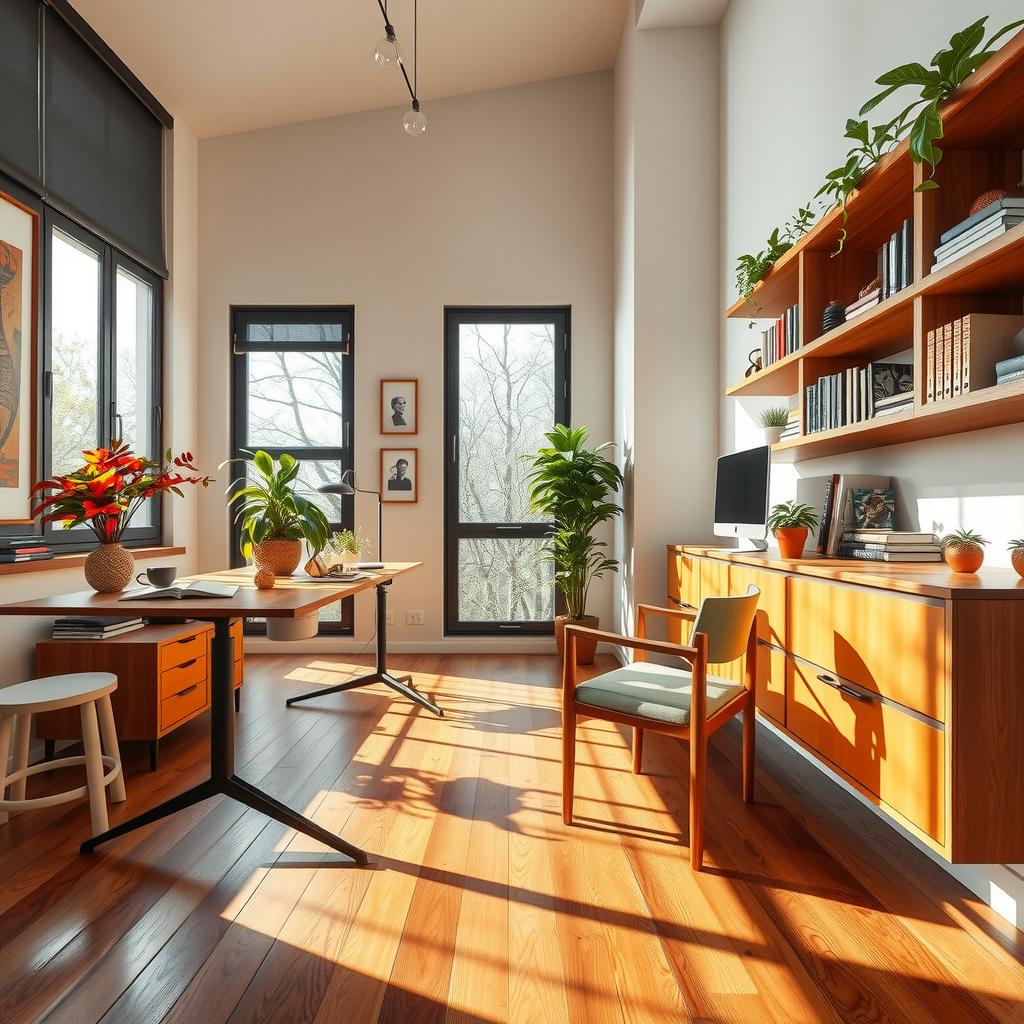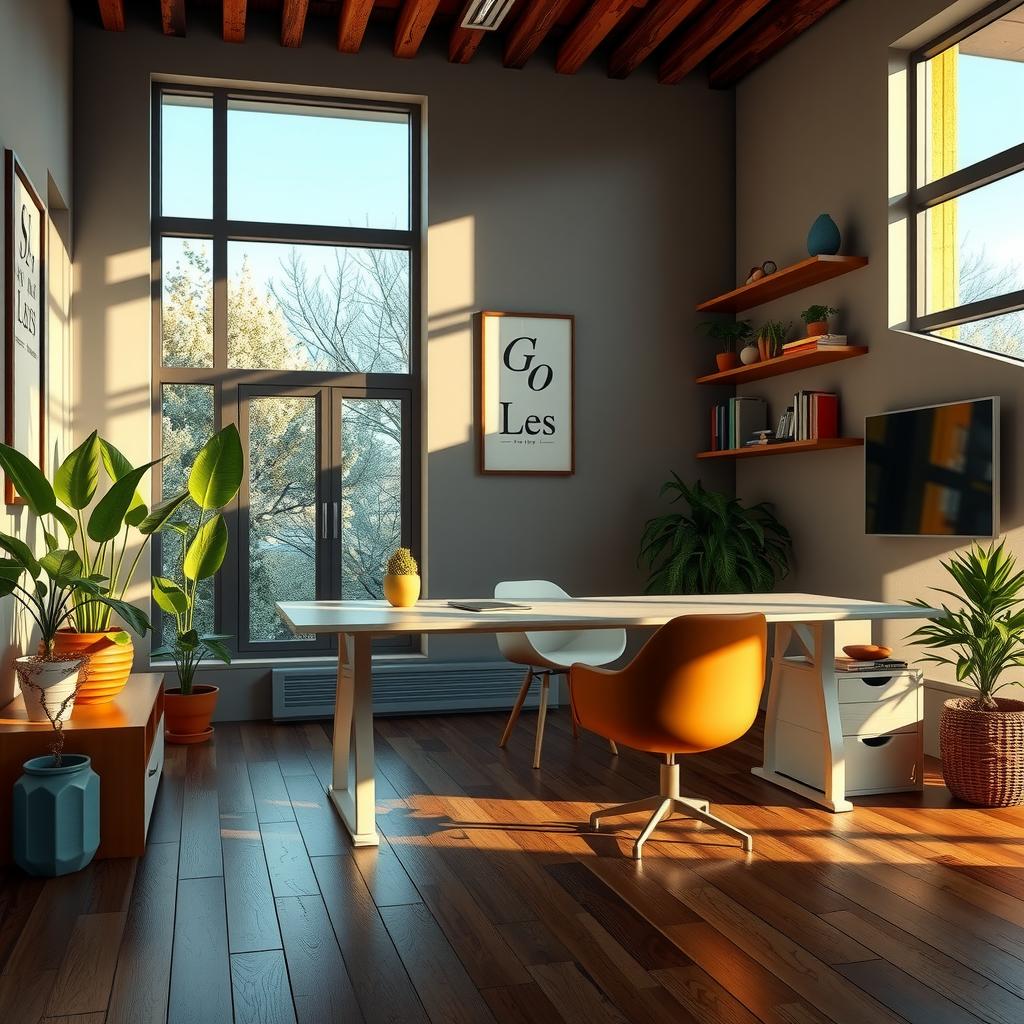In today’s fast-paced world, where the boundaries between work and home are increasingly blurred, creating a multifunctional home office has become an essential endeavor for many individuals. The challenge lies not only in finding a dedicated space to focus on professional tasks but also in ensuring that this area remains inviting and conducive to productivity. As remote work continues to solidify its place in our lives, the need for effective furniture arrangements becomes paramount—a well-designed workspace can significantly enhance performance while maintaining comfort.
The core value of establishing an efficient home office extends beyond mere aesthetics; it involves thoughtful consideration of how each piece of furniture contributes to overall functionality. By focusing on space optimization, individuals can transform even the smallest corners into dynamic work zones that cater to various needs throughout the day. From ergonomic setups that prioritize health during long hours at the desk to flexible layouts accommodating both focused tasks and collaborative sessions, there are countless solutions available.
However, navigating through options without clear guidance may leave many feeling overwhelmed or uncertain about their choices. This article aims to provide insightful organization tips and practical strategies tailored for anyone looking to revamp their workspace design effectively. Whether it’s incorporating multifunctional desks with built-in storage or selecting seating that promotes good posture while allowing seamless transitions from work mode to relaxation, understanding key principles will lead readers toward making informed decisions.
As we delve deeper into specific arrangements suited for diverse lifestyles and preferences, readers will discover how easy it is to create a harmonious environment where productivity thrives alongside comfort. Join us as we explore innovative ideas designed not just for aesthetic appeal but also aimed at elevating one’s daily experience within a multifunctional setting—where every piece plays a crucial role in achieving balance amidst life’s demands.

Key Insights:
-
Innovative Furniture Arrangements: Creative setups can optimize limited space without sacrificing style.
Effective furniture arrangements play a crucial role in creating a multifunctional home office that meets the demands of remote work and personal comfort. Homeowners can explore options such as using a sleek, compact desk paired with stylish storage solutions to maximize their workspace. Incorporating furniture pieces like modular sofas or chic bookcases allows for easy transitions between work and relaxation, ensuring that every inch of space is utilized efficiently. -
Ergonomic Setup for Enhanced Productivity: Prioritizing health while working from home is essential.
An intentional focus on ergonomic design within the workspace design fosters better posture and overall well-being, which directly contributes to heightened productivity levels. Homeowners should consider investing in adjustable desks or supportive chairs that promote healthy sitting habits during long hours of work. By creating an environment conducive to physical comfort, individuals can maintain their concentration on tasks at hand while enjoying the benefits of an aesthetically pleasing setup. -
Flexible Layouts for Dynamic Workflows: Adaptability ensures seamless transitions between different activities throughout the day.
The ability to rearrange furniture easily supports various tasks—whether preparing for video calls or needing ample surface space for creative projects. Implementing flexible layouts, such as movable carts or foldable tables, enables homeowners to craft their ideal atmosphere quickly whenever needed. This adaptability not only enhances functionality but also inspires creativity by providing diverse environments tailored to specific activities within the same area.
By embracing these strategies centered around effective organization tips and thoughtful design choices, individuals can transform any corner into an inspiring haven that balances productivity with style in today’s evolving living landscape.

Space Optimization: Maximizing Every Square Foot
Innovative Furniture Arrangements for Enhanced Productivity
In today’s fast-paced world, the importance of space optimization in both residential and commercial settings cannot be overstated. As more individuals embrace remote work or hybrid models, the demand for effective workspace design has surged. One efficient way to achieve this is through innovative furniture arrangements that not only enhance productivity but also maintain a visually appealing environment. By integrating multifunctional home office solutions such as convertible desks and modular shelving units, users can create flexible layouts that adapt to varying needs throughout the day.
The key lies in understanding how different furniture arrangements impact daily tasks. For instance, placing a desk near natural light sources can improve mood and focus while maintaining an ergonomic setup that promotes health during long working hours. Furthermore, utilizing vertical space with tall bookshelves or wall-mounted storage options allows occupants to maximize every square foot without sacrificing aesthetic appeal. This approach fosters an organized atmosphere conducive to creativity and efficiency.
To illustrate this concept further, consider a compact apartment where every inch counts. In such spaces, incorporating items like foldable chairs or nested tables becomes crucial; they provide additional seating when needed but can easily be stored away when not in use. Additionally, open shelving systems offer accessibility while keeping essential materials within arm’s reach—an excellent organization tip for maintaining order amidst bustling schedules.
Moreover, embracing flexible layouts encourages adaptability among occupants who may have fluctuating responsibilities each day. For example, if one day requires extensive paperwork while another necessitates virtual meetings via video calls, adjustable partitions or mobile desk units allow users to reconfigure their environments quickly according to immediate demands without cluttering their space unnecessarily.
As organizations increasingly recognize these benefits of thoughtfully designed workspaces equipped with versatile furniture solutions like standing desks or collaborative meeting pods—productivity solutions become apparent across various sectors striving towards improved employee satisfaction levels alongside enhanced output quality overall.
Ultimately achieving effective space optimization hinges upon balancing functionality with style—a principle echoed by countless successful professionals seeking harmony between their personal lives and careers alike! By implementing strategic arrangements tailored explicitly towards maximizing utility whilst sustaining visual allure—the modern workforce stands poised at its best self yet!
Ergonomic Furniture Choices: Promoting Comfort and Health
The Essential Role of Ergonomics in Workspace Design
In today’s fast-paced work environment, the significance of selecting ergonomic furniture cannot be overstated. With many professionals spending extensive hours at their desks, the consequences of poor posture can lead to a myriad of health issues including back pain, neck strain, and decreased productivity. By integrating ergonomic pieces into workspace design, individuals can foster an atmosphere that nurtures both comfort and health. For instance, investing in an ErgoChair Pro or a Sit-Stand Desk Converter not only provides adjustable seating options but also encourages movement throughout the day. This flexibility is crucial for maintaining healthy posture during long working hours.
Moreover, incorporating multifunctional home office furniture enhances space optimization while providing essential support for daily tasks. A well-designed workspace with modular storage solutions allows professionals to keep their environments organized without sacrificing comfort or accessibility. Consider a versatile desk like the Flexispot E7, which adapts seamlessly between sitting and standing positions—encouraging better circulation and reducing fatigue over time. When paired with accessories such as an adjustable monitor stand or ergonomic keyboard tray, these enhancements contribute significantly to achieving an ideal ergonomic setup.
To further improve work efficiency, implementing effective organization tips plays a critical role in creating flexible layouts that cater to individual needs. An organized workstation minimizes distractions while promoting focus on essential tasks; thus enhancing overall productivity solutions within any workspace design framework. Maintaining clutter-free surfaces fosters mental clarity—a vital aspect often overlooked amidst busy schedules.
In summary, prioritizing ergonomics when choosing office furniture is imperative for anyone aiming to enhance their health and productivity during long hours of work. The transition towards more thoughtful arrangements not only benefits physical well-being but also cultivates a more engaging work atmosphere where individuals can thrive professionally without compromising comfort or safety.
The Importance of Flexible Layouts in Modern Workspaces
Transform Your Environment for Every Task
In today’s dynamic work environment, having a flexible layout is essential. Understanding how to shift furniture arrangements can significantly enhance productivity and efficiency, making it easier to transition between activities like video calls and creative projects. For instance, an ergonomic setup with a height-adjustable desk allows users to switch from sitting to standing positions seamlessly during long meetings or brainstorming sessions. This adaptability not only caters to physical comfort but also fosters better focus and creativity. By utilizing multifunctional home office furniture such as modular sofas or collapsible tables, individuals can maximize their available space while ensuring that the workspace design accommodates various tasks effortlessly.
Creating a workspace that adapts requires thoughtful planning around space optimization principles. One effective strategy involves zoning the area based on task types—designating sections for collaborative efforts versus individual work. Ergonomic chairs paired with specific desks designed for different functions can facilitate smoother transitions between these zones. During video conferencing, for example, arranging seating in an inviting manner encourages engagement while maintaining professionalism; this might mean repositioning chairs closer together or adjusting lighting systems like ring lights for optimal visuals on camera without losing comfort. Moreover, integrating smart storage solutions helps keep the workspace organized by providing quick access to necessary materials without cluttering surfaces.
Creative Configurations Enhance Productivity
Maximizing Workspace Design Through Versatility
Innovative furniture arrangements are more than just practical—they’re crucial for fostering creativity within any setting. When engaging in projects that require imaginative thinking or collaboration among teams, flexibility plays a pivotal role in stimulating ideas flow and enhancing overall output quality. Utilizing versatile shelving units allows items needed at hand’s reach while effectively clearing desktop spaces during intense project phases contributes greatly towards maintaining focus amid distractions present in most environments today.
Additionally, employing technology tools tailored toward interactive sessions aids this transformation further; wireless presentation equipment enables seamless sharing of ideas across varied setups quickly shifting from one task type into another swiftly without interruption—a prime example being using projectors when moving from individual reflection time into group discussions requiring open dialogue exchange amongst participants involved actively engaged within collective decision-making processes driving successful outcomes ultimately achieved through strategized organization tips presented throughout these interactions defining clear objectives set forth before commencement leading up towards desired results accomplished therein proficiently executed under pressure consistently over time thus resulting ultimately elevating team morale collectively empowering individuals contributing towards shared goals manifestly realized through cohesive teamwork exhibited naturally stemming from adaptable settings established initially through careful consideration taken beforehand regarding proper functionality intended originally envisioned detailed plans outlined preceding execution stages implemented systematically ongoing evaluations conducted periodically thereafter assessing effectiveness continually seeking improvements where applicable nurturing growth potential realized reciprocally benefitting everyone participating collectively reaching higher levels success attained together collaboratively.”
Frequently Asked Questions:
Q: How can I optimize my small space for a multifunctional home office?
A: To achieve effective space optimization, consider using modular furniture that can easily adapt to your needs. For example, a foldable desk allows you to create an efficient workspace when needed and store it away when not in use. Additionally, incorporating vertical storage solutions like shelving units can help keep your materials organized without taking up valuable floor space.
Q: What are some essential ergonomic setups for my home office?
A: A proper workspace design should prioritize comfort and health. Look for ergonomic chairs that support good posture during long hours of work. Pairing these with adjustable desks ensures that you can switch between sitting and standing positions effortlessly, enhancing overall productivity as you tackle daily tasks in your multifunctional home office.
Q: How do flexible layouts improve productivity in a home office?
A: Flexible layouts allow individuals to rearrange their furniture according to specific tasks throughout the day. For instance, creating an area designated for video calls with appropriate lighting and background elements promotes professionalism while working from home. By strategically placing items such as monitors and stationery supplies within arm’s reach, one can significantly boost efficiency while enjoying a chic environment designed for both work and relaxation.